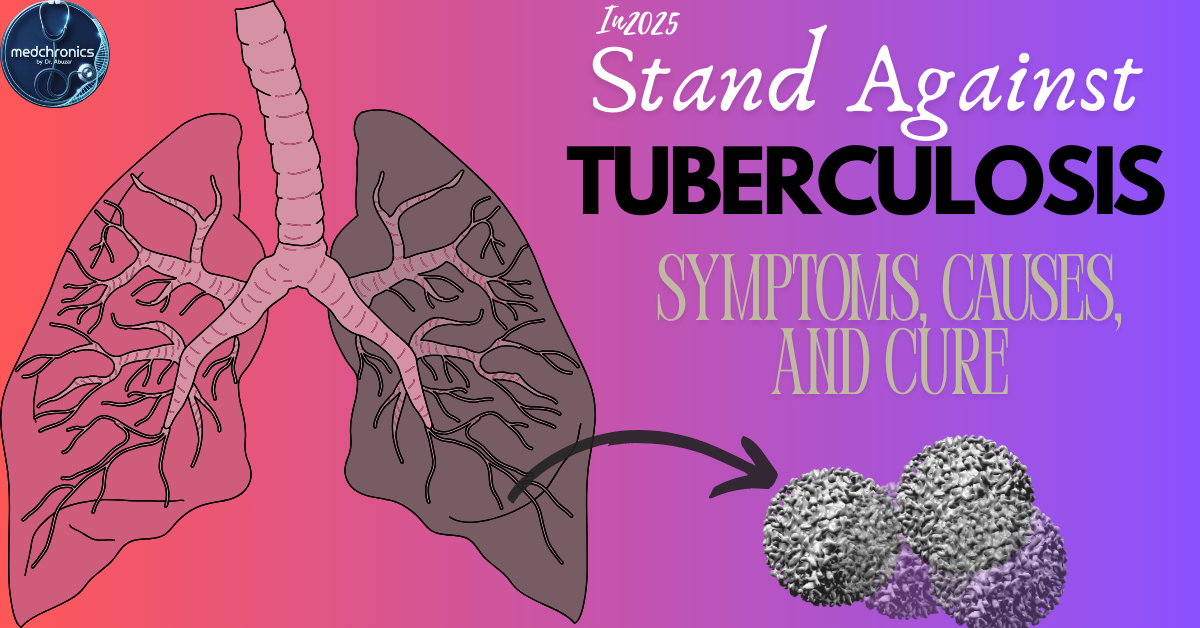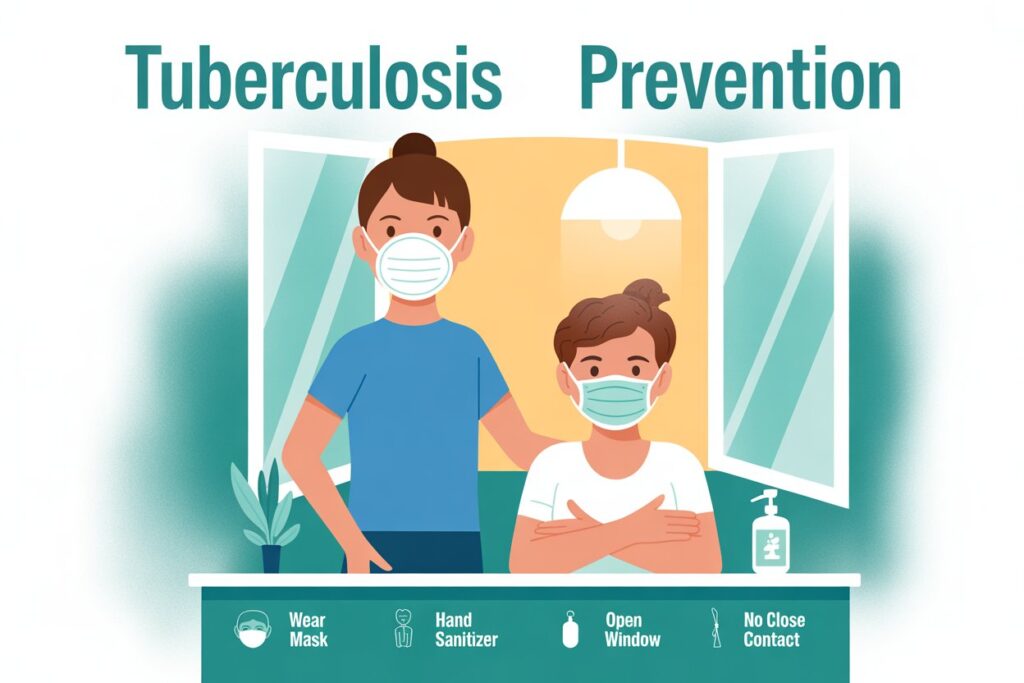Introduction
Tuberculosis, widely known as TB(Koch), is a highly infectious disease caused by the bacteria “Mycobacterium tuberculosis”. While it most commonly affects the lungs, in advanced or untreated cases it can spread to other vital organs such as the brain, kidneys, and spine, leading to severe complications.
The greatest danger of TB lies in its ability to remain silent in the body for months or even years. The infection might turn lethal if treatment is not received. However, there is good news—TB is one of the few major infectious diseases that is completely curable with timely diagnosis, consistent treatment, and proper medical care.
A illness that has existed for centuries, tuberculosis still affects millions of people worldwide. Despite being one of the deadliest infections, it is entirely preventable and curable if detected early and treated properly.
The biggest danger is not the disease itself but incomplete treatment, which allows drug-resistant TB to spread. Each missing dose contributes to the difficulty of curing tuberculosis.
Therefore, awareness, strict adherence to treatment, healthy lifestyle practices, and early medical consultation are the strongest tools we have to win the fight against TB.
Table of Contents
Historical Background
TB is not a disease of modern times; its presence dates back thousands of years. Archaeologists have discovered evidence of TB in ancient Egyptian mummies, showing that it plagued humanity even in early civilizations.
In ancient Greece and Rome, TB was referred to as “phthisis,” meaning wasting disease, because patients became thinner and weaker over time.
By the 19th century, it was commonly called “consumption,” highlighting how it seemed to consume the strength of those infected.
The turning point in TB history came in 1882, when Dr. Robert Koch, a German physician and microbiologist, identified the bacterium Mycobacterium tuberculosis. His discovery was revolutionary—it paved the way for accurate diagnosis and later, the development of effective treatments.
Before antibiotics, TB was a death sentence for many, especially in overcrowded cities. Sanatoriums were built where patients were kept isolated, with fresh air and rest considered the main therapy. Today, thanks to antibiotics, vaccines, and global awareness, TB can be controlled and cured—yet it still remains a leading cause of death in many parts of the world.
Global Burden and Statistics
TB continues to be a major public health challenge worldwide. The World Health Organization (WHO) reports:
About 10 million people annually contract active tuberculosis.
Nearly 1.3 million deaths occur annually, making TB one of the top infectious killers globally.
With 26% of all TB cases worldwide, India is the country with the largest burden.
Multi-Drug Resistant TB (MDR-TB) is on the rise. This occurs when the TB bacteria no longer respond to the two most powerful drugs (Isoniazid and Rifampicin), making treatment more complex and lengthy.
Types of Tuberculosis
TB manifests in different forms, depending on the body’s immune response and the organs involved:
1- Latent TB Infection (LTBI)
The bacteria remain in the body but in an inactive (dormant) state.
No symptoms are present, and the person is not contagious.
However, if immunity weakens (due to HIV, diabetes, or malnutrition), latent TB can turn into active TB.
2- Active TB
Bacteria multiply and symptoms appear.
This phase is invasive and spreads through the air.
3- Pulmonary TB
TB that affects the lungs. The great majority of cases are of this type, which is particularly ubiquitous.
4- Extrapulmonary TB
When TB spreads beyond the lungs to other organs, such as:
- Kidneys → blood in urine
- Brain (TB meningitis) → severe headaches, confusion, seizures
- Spine (Pott’s disease) → back pain, deformities, paralysis if untreated
- Lymph nodes → swelling in the neck or armpits
Symptoms of TB
TB develops gradually, which often delays diagnosis. Common warning signs include:
- Persistent cough lasting longer than 2–3 weeks
- Coughing up blood or mucus with blood
- Fever (often low-grade but persistent)
- Night sweats (soaking clothes and bedsheets)
- Sudden, unexplained weight loss
- Constant fatigue and weakness
- Chest pain or difficulty breathing
It is important to note that symptoms may differ depending on whether it is pulmonary or extrapulmonary TB. Examples of this include blood in the urine may indicate kidney TB, whereas headaches and neurological problems may indicate TB meningitis.
Causes and Transmission of TB
TB is caused by Mycobacterium tuberculosis. The bacteria spread through the airborne route when a person with active TB coughs, sneezes, laughs, or even talks. Tiny droplets carrying the bacteria can be inhaled by others, leading to infection.
Important facts about transmission:
- Handshakes, food sharing, and contact are unable to transmit tuberculosis.
- Prolonged, close contact increases the risk (e.g., within families or crowded workplaces).
Risk factors that increase TB vulnerability include:
- Weak immune system (HIV/AIDS patients are at high risk)
- Diabetes
- Malnutrition and poor diet
- Smoking and alcohol use
- Living in overcrowded, poorly ventilated, and unhygienic spaces
What to Do If Someone Has TB
Seek medical attention immediately. TB can be confirmed through tests such as:
- Sputum test (checking for bacteria in mucus)
- Chest X-ray
- Tuberculin skin test (Mantoux test)
- Molecular tests (GeneXpert) for rapid detection
Treatment usually lasts 6–9 months. Medicines must be taken exactly as prescribed without skipping doses.
Do not stop treatment midway. Interruptions can lead to drug resistance (MDR-TB).
Patient should:
- Wear masks when around others.
- Use separate utensils, towels, and bedding.
- Cover their mouth when coughing or sneezing.
- Stay in well-ventilated rooms
When to See a Doctor
Immediate consultation is needed if you experience:
- Cough lasting more than 2 weeks
- Coughing up blood
- Unexplained fever, night sweats, and weight loss.
- Swollen lymph nodes or unexplained chest pain
Preventing TB
Vaccination: The BCG vaccine, given in childhood, provides partial protection, especially against severe forms like TB meningitis.
Keeping yourself clean and ventilated is important since TB bacteria can’t develop in fresh air or UV light.
Nutrition: A healthy diet strengthens immunity and lowers risk.
Protective measures: Masks and physical distancing for patients in treatment.
Awareness: Educating communities about symptoms and treatment is essential to stop spread.
Treatment of TB
TB treatment follows the Directly Observed Treatment, Short-course (DOTS) strategy, recommended by WHO. This ensures patients take their medicines regularly under medical supervision.
Phases of treatment:
1- Intensive Phase (first 2 months):
Combination of 4 drugs: Isoniazid, Rifampicin, Pyrazinamide, Ethambutol
Purpose: Rapidly kill bacteria and reduce contagiousness
2- Continuation Phase (next 4–7 months):
2–3 drugs are continued to kill remaining bacteria Purpose: Prevent relapse and resistance
3- MDR-TB Treatment:
Requires stronger drugs (e.g., Bedaquiline, Linezolid) and sometimes injections
Treatment may last 18–24 months and has more side effects With full adherence, TB is 100% curable. Patients must never stop medication prematurely.
A illness that has existed for centuries, tuberculosis still affects millions of people worldwide. Despite being one of the deadliest infections, it is entirely preventable and curable if detected early and treated properly.
The biggest danger is not the disease itself but incomplete treatment, which allows drug-resistant TB to spread. Each missing dose contributes to the difficulty of curing tuberculosis.
Therefore, awareness, strict adherence to treatment, healthy lifestyle practices, and early medical consultation are the strongest tools we have to win the fight against TB.
Frequently Asked Questions
Q: What is Tuberculosis (TB)?
Tuberculosis, or TB, is an infectious disease caused by Mycobacterium tuberculosis bacteria. It mainly affects the lungs but can also spread to other parts of the body if untreated.
Q: What are the early symptoms of Tuberculosis?
Common symptoms include a persistent cough (lasting more than 2 weeks), fever, night sweats, chest pain, unexplained weight loss, and coughing up blood.
Q: How does Tuberculosis spread?
TB spreads through the air when an infected person coughs, sneezes, or speaks. Close and prolonged contact increases the risk of infection.
Q: Is Tuberculosis curable in 2025?
Yes. With proper antibiotics, TB is curable. Modern treatment regimens and new drugs in 2025 make the recovery process more effective and safer.
Q: How can TB be prevented?
Prevention includes wearing masks around TB patients, ensuring good ventilation, following cough etiquette, completing TB vaccination (BCG), and avoiding close contact with infected individuals.
Q: Who is most at risk of Tuberculosis?
People with weak immune systems, such as those with HIV/AIDS, diabetes, or malnutrition, are at higher risk. Health workers and individuals living in crowded conditions are also more vulnerable.

